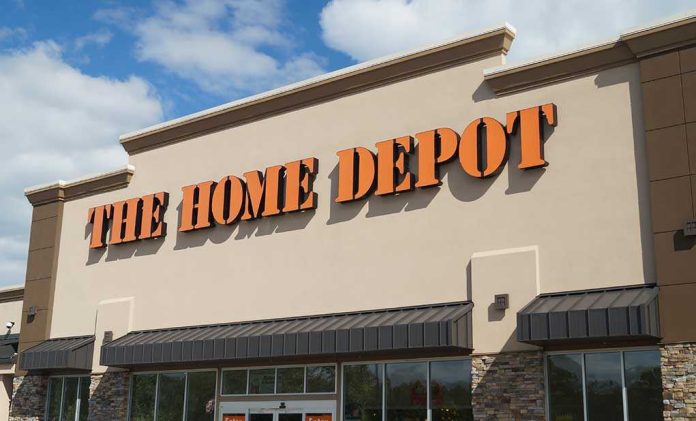
Home Depot’s massive $5.5 billion acquisition of GMS Inc. signals a dramatic shift away from cheap labor dependency as American businesses prepare for a future where workers are scarce and automation is essential.
Key Takeaways
- Home Depot’s acquisition of GMS Inc. for $5.5 billion represents a strategic pivot toward automation and supply chain optimization in anticipation of continued labor scarcity.
- The company is building a resilient business model less dependent on low-skilled labor by consolidating distribution networks and investing in technology-driven solutions.
- This acquisition, following the $18 billion purchase of SRS Distribution, creates a massive network of 1,200 locations and 8,000 trucks to dominate the contractor supply market.
- The strategic shift aligns with President Trump’s immigration and tariff policies, which encourage domestic investment and production over reliance on foreign labor and materials.
- Wall Street may misinterpret these moves as simply consolidation plays, missing the fundamental adaptation to a labor-scarce, limited-immigration environment.
A Strategic Response to America’s Changing Labor Landscape
Home Depot’s acquisition of GMS Inc. through its subsidiary SRS Distribution marks a profound shift in American business strategy. This $5.5 billion investment follows an earlier $18 billion purchase of SRS Distribution, demonstrating the company’s commitment to restructuring operations for a future where labor is no longer cheap or abundant. The retailer is doubling down on the business-to-business supply chain for building contractors, focusing on higher-margin, capital-intensive businesses that require fewer workers relative to revenue generated. This strategic realignment comes as companies across America recognize that the era of assuming limitless low-skilled labor is ending.
The move integrates GMS’s network of approximately 320 distribution centers with SRS’s already substantial national footprint. Together, these acquisitions give Home Depot control over 1,200 locations and a fleet of 8,000 trucks—creating unparalleled logistical capabilities in the building materials sector. By consolidating these distribution networks, Home Depot gains efficiency through scale while reducing vulnerability to labor market fluctuations. The company is essentially betting that the future of American business lies in automation, centralization, and process optimization rather than labor-intensive operations.
“The golden age for employers is coming to an end,” said Adrian Wooldridge.
Building Domestic Supply Chain Resilience
Home Depot’s acquisition strategy directly responds to growing U.S.-China trade tensions and increasing tariffs on imported building materials. By securing domestic distribution networks and supply chains, the company insulates itself from international trade disruptions while positioning to better serve American contractors with locally sourced materials. The retailer’s $110-per-share offer for GMS—which surpassed QXO’s $5 billion bid—demonstrates its determination to dominate the contractor market and create an integrated ecosystem of building material supply.
GMS specializes in drywall, framing, and tool services—all essential components for construction projects that complement Home Depot’s existing retail operations. This acquisition allows Home Depot to vertically integrate its operations, capturing more value throughout the construction supply chain while reducing dependency on external vendors. The strategic emphasis on domestic suppliers directly aligns with President Trump’s economic policies, which have incentivized American companies to invest in local production capacity and reduce reliance on foreign manufacturing.
The End of the Cheap Labor Era
What makes Home Depot’s acquisition particularly significant is its acknowledgment that the business environment is fundamentally changing. Reduced immigration and growing political opposition to mass migration have constrained the labor supply that many industries previously took for granted. Rather than lobbying for expanded visa programs, forward-thinking companies are investing in logistics networks, sponsoring apprenticeship programs, and accelerating investments in AI and automation technologies. This represents a reversal from the past model of importing workers to fill labor gaps.
The broader trend extends beyond Home Depot to construction and logistics sectors generally, where companies are working to automate and centralize operations while minimizing labor touchpoints. This transformation is driven by macroeconomic factors, including Trump’s immigration policies and tariffs, which have reshaped the business landscape. Companies that adapt quickly to this new reality by building domestic capacity and reducing labor dependency will likely outperform those that cling to outdated business models predicated on cheap, abundant labor.
Investment Implications and Future Outlook
Investors should pay close attention to companies with vertical integration strategies, domestic production capabilities for critical materials, and strong contractor relationships. The Home Depot–GMS deal exemplifies how forward-looking firms are adapting to a labor-scarce environment where scale and efficiency are prioritized over traditional expansion models. While Wall Street analysts may focus on potential antitrust concerns in these consolidation deals, they often miss the underlying driver: adaptation to structural labor scarcity rather than simple market dominance plays.
The capital-intensive nature of reshoring and supply chain optimization favors larger firms with strong financial positions, like Home Depot. Smaller companies may struggle to make the necessary investments in automation and distribution infrastructure. As this trend accelerates, we can expect more strategic acquisitions aimed at securing domestic supply chains and reducing labor dependency. The companies that successfully navigate this transition will emerge stronger, with more resilient business models capable of withstanding future economic and geopolitical challenges in an increasingly uncertain global environment.














